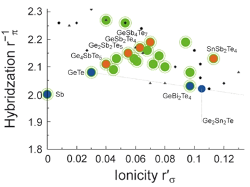Structure and material complexity
In this topical area, we focus on design rules for materials that can be utilised as resistively switching chalcogenides. To do so, our goal is to identify rational design strategies for VC systems and to further elaborate those found for PC systems. To date, new PCMs are still commonly found by trial and error. However, recent work in our groups suggests that these materials can be identified by a unique bonding mechanism that fundamentally deviates from the textbook cases of ionic, metallic, and covalent bonding. Using this insight, we were able to develop a new map for PCMs which is not based on semiempirical observations but, instead, on quantum-mechanically guided coordinates. This map helps to identify novel phase change materials and apparently also predicts important property trends. Hence, we want to explore in the third funding period how this map can be employed to tailor switching kinetics, and the reliability of phase change materials.
With respect to a materials treasure map for VCM, we have clarified in the last period, that the current transport in the different states and the dynamics of the devices are not determined by the oxide materials alone but by the interfaces to the metal electrodes, namely by Schottky barriers and by oxide layers formed as a result of the reaction with the metal electrodes or by segregation processes. The driving force for interfacial chemical reaction at the oxygen exchange electrode depends on the defect formation energy of oxygen vacancies in the metal oxide at the interface. We could show a systematic trend of the forming voltage, the RESET kinetics and the RON/ROFF ratio for metals with different free energy for metal oxide formation and, associated, different formation energy of oxygen vacancy defects at the metal-oxide interface. Furthermore, the barrier for oxygen diffusion in this interface layer strongly determines the retention times of the VCM devices. Therefore, a rational materials design for VCM has to consider heterostructures of different oxides and metal layers and not only the bulk properties of the oxide materials themselves.
In the first two funding periods, we focused on filamentary switching systems. However, the stochasticity of the filament formation goes along with an inherent variability and causes a set of trade-offs for the reliability such as the retention endurance trade-off and the scaling-variability trade-off. We will therefore intensify our running activities on AD systems in the third period of the SFB and compare them with respect to their scaling potential, their switching kinetics and their reliability.
We will continue with the oxides selected for the previous period, namely SrTiO3, TiO2, HfO2 and Ta2O5 and will investigate the impact of the differences in their electronic structure, defect formation energies (anion and cation site) and energy barrier for ionic transport on the device performance. HfO2 and Ta2O5 have been identified by the industry as the most promising materials for ReRAM applications and will therefore be in the focus of the third period.
AD switching systems usually consist of heterostructures of (1) a highly oxygen deficient, n-conduction or a p-conducting oxide and (2) a thin highly insulating tunnel oxide layer. We will therefore extend our oxide materials by p-conducting manganites such as PCMO and LSMO, which we started to explore in the previous funding period. We will combine them with tunnel oxide layers such as YSZ and Al2O3 or with interface oxides formed with different metal electrodes. We will furthermore continue our research on the VO2 Mott-type insulator-to-metal systems which represents, due to the competition between phase change and valence change, a highly interesting bridge between VCM and PCM systems.

